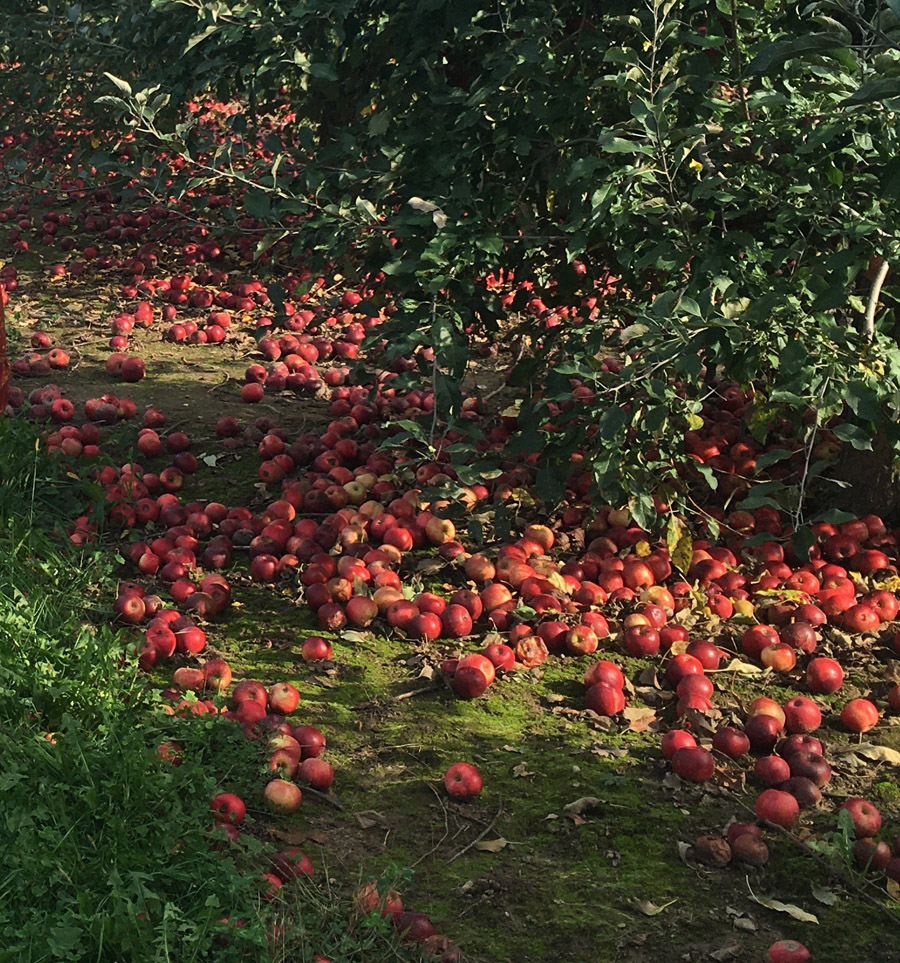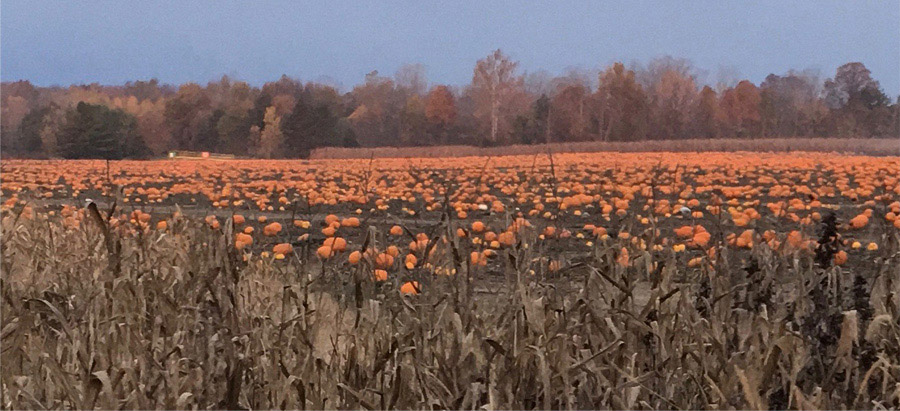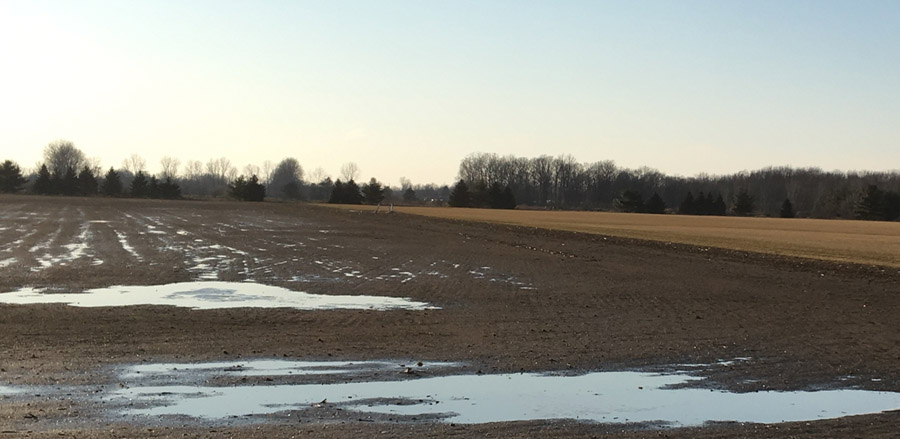What could be more postmodern than a farm that shifts from producing produce, to producing the performance of producing produce?
That was the curious question that kept poking at my mind as I traveled through the gorgeous autumn countryside last year, with a friend who was seeking some fresh-picked apples.
We wanted to get them the old-fashioned way, so we were headed to a popular country orchard that advertises u-pick apples, on a family farm whose operation has spanned many generations. Nothing modern about that, right? Much less “postmodern,” whatever that is.
But it was a trip to this century-old farm that finally taught me the difference between modern and postmodern — and that seeking a throwback experience might throw us more squarely into the present, than into the past.
Applecarts and alleyways
The orchard visit was her idea, but I was highly supportive. I had not been to a commercial apple orchard since I was a toddler.
On that long-ago autumn day, my kindergarten class was herded onto a school bus that carted us off to the cider press at Wiard’s Orchards, near Ypsilanti, Michigan. I remember little else but a stream of fresh-pressed cider, its foamy rivulets trickling down into the vee of a wide wooden trough, where it gathered speed until it crashed into a corner, welling up momentarily as adults dipped it up to give to the children. Like all the other children, I was given a bit, in a tiny paper cup. It was good — so good that it was not enough. But I was too shy to ask for more.
Wiard’s was typical of the large, modern orchard of the mid-twentieth century — a highly productive concern that shipped large quantities of apples of every stripe, into every tendril of the apple grower’s Sankey diagram. The best grades were designated for fresh sales at grocery stores, and other grades dutifully assigned to a range of less demanding roles. Nothing was wasted. In the photo below, large quantities of presumably the lowest grade are being staged for the vinegar plant. Note the schoolchildren at right, taking the same kind of trip that I took.

Busy, busy, busy
Wiard’s was a genuine working farm. The school outings for cider, and the little retail shop, were just a sideline, almost an expectation really — an extension of the age-old tradition of the community cider press, where local citizens would bring apples from their own orchards to have them pressed into cider. But the real business was apples — commercial apples, in bulk commercial quantities, seeking their highest use: if not tumbling down the meticulously-stacked fruit displays of the local grocery stores, then riding the rails to distant cities, or providing feedstock for bulk commodities like apple juice, apple jelly, and those huge institutional cans of applesauce that the school lunch ladies used.
It must have been an amazing scene — an army of itinerant pickers, toting their baskets and poking their ladders into the burdened boughs; mechanical tree-shakers and their collector screens, unfolding like a peacock’s tail under the leafy canopy; and a busy collection yard, fortified with towers of pallets, walls of apple crates, and even the occasional apple cart, all seemingly built from the same gray, weathered boards as the tumbledown sheds scattered about the grounds.
This is why people wanted to come. It was the age-old institution of the fall harvest, when the peaceful repose of a balmy summer would suddenly collapse into frenetic but orderly chaos. To welcome tour groups and schoolchildren at such a time was a generous gesture. But they needed to keep out of the way.
A second bite at the apple
The orchard that I visited with my friend seemed to be a similar operation, at first. The property was expansive, the trees were mature, and they had the right spacing to accommodate the usual harvesting machinery. The apples we picked from the trees were plump, sweet, and flawless.
And yet, it was apparent that the apples were not being harvested, and they weren’t going to be.
Thousands upon thousands were paving the otherwise bare ground beneath the trees. Most appeared to have dropped naturally as they ripened. Watching the many visitors filtering through the alleyways with their children, it was clear that many had been picked out of curiosity, and then dropped after a single bite. Seeing that others were doing it, we did it a couple of times ourselves. At times I felt like I was walking through a cow pasture, as I discovered the discards in random places, soft with decay, beginning to fill the treads of my shoes.

As a footnote to this scene of decadent, carefree abundance, not far away was a small vineyard, where table grapes withered on the vine, slowly turning into rustic raisins that the local birds were already tired of stealing.

But celebrate!
If the grapes weren’t getting much attention, there was an abundance of activity nearby. This was the weekend of the orchard’s annual apple festival.
A fallow grass field of many acres served as the parking lot, and was subdivided into a maze by brightly colored pennants. The entry was overseen by a number of attendants collecting three-dollar donations, optional but appreciated, peeling change from a large roll of cash. Across the road at the farm, police officers were assigned to directing traffic and lending a sense of order to the scene. An ambulance was staged nearby, in case of emergency. A live band played loudly under a canopy, shielding all but the crowd from the blistering sun. A large retail store was bursting with value-added apple products, for which throngs of unmasked customers sweltered as they waited in line to pay. Stands selling crafts and street food were scattered about the grounds, doing brisk business with the people milling about.
It was a fun and festive scene. But for a celebration of apples, there were not that many to be seen. The guest of honor was loitering in the orchard, largely on the ground.

I could only ask myself: what gives? Yes, the guests were picking a few apples, but where were the harvesting crews, the tree-shakers, the cavernous bins of apples, the constant urge to get out of the way?
We speculated that perhaps the pandemic-related shortage of farm workers could have been to blame. Perhaps that was part of it. But the vineyard seemed small enough that, if this were really the bucolic “family farm” that we were allowed to imagine it was, then certainly a single family member, or an idle cousin from down the road, could have been recruited to pluck every grapebunch from every vine in a single afternoon, if they were wanted. But there they were, fermenting on the vine.
My friend then posed for a selfie in front of them. She was perfectly color coordinated.
Detached at the hip
Judging from the big crowds that were visiting, I began to wonder if a commercial harvest had even been part of the plan.
Despite the waste, this farm seemed to be making a lot of money. It must have consumed the same inputs — commercial fertilizer and fossil fuels — that other farms consume. But in focusing on the festival and the u-pick business, they seemed to be converting these inputs to entertainment, more so than food.
It reminded me of an infamous quote, attributed to an executive of McDonald’s:
“We are not technically in the food business. We are in the real estate business. The only reason we sell fifteen-cent hamburgers is because they are the greatest producer of revenue, from which our tenants can pay us our rent.”
– said to be a quote of Harry J. Sonneborn, early McDonalds executive
At a gut level, the pragmatic detachment that this quote reveals strikes most people as rather discomforting, if not daft. It isn’t quite intuitive that the implicit mission of a hamburger restaurant, to serve hamburgers, need not constrain its business model at all. But it means that, if someday we walk into a McDonald’s and encounter, instead of hamburgers, a full-service real estate agency, or a full line of designer tea cozies, we shouldn’t feel anything is amiss. It’s just the invisible hand of capitalism, delivering what rewards it best.
Old-time? Modern? … or Postmodern?
A week later, I was still pondering my visit to that oddly-operated orchard. Was my dwindling peck of fresh apples, picked with my own hands and purchased directly from a family farm, evidence that I had “done it the old-fashioned way?” It didn’t feel like it, exactly.
When we think of farm life, we think of: multigenerational ties to the land; longstanding tradition; frugality and economy; having one hand in the soil and one in the compost. To buy produce directly from a farm, we assume, is to reject some of the confusion and waste that the modern world surrounds us with — to bypass the dueling business models of Whole Foods and Wal-Mart, and instead connect to an earlier and simpler time. But the mounds of wasted fruit, and the boisterous festival, suggested that my experience there was still part and parcel of the puzzling present.
Ok, so today’s farms can’t be too old-fashioned. They have to embrace modern conveniences to stay competitive. Today, harvesting totes and apple crates are made of plastic, not wicker or wood anymore; chemistry outranks composting. By those measures, that orchard was certainly modern.
But calling it a “modern” experience doesn’t tell the whole story either. A modern, working farm would still focus on the fruit, and bringing it efficiently to market. It would have little extra bandwidth to host visitors and hold festivals.
So, if my orchard experience was neither traditional nor modern, what was it? Perhaps it was postmodern.
“Postmodern” is a very slippery term. Here I’m applying it to society and its behaviors, instead of its more common connotations in art or architecture. I had only a very tenuous grasp of the concept when it suddenly popped into my head, as I was treading among the squishy apples. When I got home, I had to look it up, to be sure I was using it right.
One of the most common definitions was something along the lines of: “that which comes after the modern.” Not helpful. But as I bounced between Merriam-Webster, Wikipedia, and other sources, trying to subject it to a more precise definition, it only squirmed like a toad. Which is apt: one of the definitions referred to an “opposition to the stability of meaning.”
After tracing a few circles around this self-referential rabbit hole, the most useful definition I could pin down was (paraphrasing): “a worldview that rejects some aspects of modernism, while retaining much of the rest.”
But then, what is modernism? Broadly, it’s the worldview that most of us know best. It expressly values reason and science as a valid and appropriate basis for the pursuit of human endeavors, and establishes some prevailing cultural assumptions for what is worthy of pursuing and what is not. As a worldview, modernism has shaped almost everything in the Western world that is different from the experience of living in, say, 1500s Europe, or as a pre-contact native American, or even as a citizen of ancient Greece or Rome.
Thus, what we know as modern agriculture is simply a modern worldview applied to crop production. Modern agriculture logically assumes that the purpose of a farm is to produce crops, and hence, that maximizing crop yield and reliability are primary objectives of farming. But a postmodern view might reject this assumption, and conclude that, while food production certainly is one possible purpose of operating a farm, the assumption that it is the best or the only one is just an ideology — and no more objectively true than any other. Thus it can be rejected, in favor of other interpretations.
By this logic, a farm begins to become postmodern when the modern farmer, perhaps stressed by the difficulty of turning a profit on the limited potential yield of their small farm, chooses to double down on the convenience and reliability of “modern” agricultural practices, while rejecting the assumption that it must lead to the marketing of its crops. This epiphany admits them to a new and exciting world: one where crop production is still routine and reliable, but the traditional harvest and all of its demands are entirely optional. A sufficiently picturesque and alluring farmstead, laden with bountiful crops, might earn a lot more by entertaining visitors — and finally, the books might balance.
The final clincher is self-referentiality — a common hallmark of the postmodern, at least in the artistic sense. A farm whose products include the celebration of its own existence is about as self-referential as it can be.
Welcome to our genuine, real, authentic family farm
From my brief visit to the orchard, I can’t be sure how completely its operators had embraced the business of entertainment over that of producing food. Maybe it was just a difficult year.
But there are plenty of country farms that could definitely be candidates for the label of “theme farm” — farms whose business model has begun to turn away from the sale of crops, toward growing crops as props, for a season of farm theater.
Here, the public is invited to “celebrate” the tradition of farming, by immersing themselves in activities consistent with the popular perception of a farm. You can stroll expansive grounds on rustic dirt paths, gather florist-quality flowers directly from the fields, frolic among acres of brilliant sunflowers and golden pumpkins, and take as many selfies as you wish. Often these activities are augmented by others that have nothing to do with farming — perhaps face-painting, or tricycle races, or hands-on craft lessons, or open-air karaoke.

The revenue ratio of entertainment-to-crops varies, but it’s plenty to make an old-school farmer harrumph. Such activities would definitely qualify as “getting in the way,” especially in the middle of the harvest season. But here, the visitors are the harvest, and the produce plays mainly a supporting role.
If you grow it, they will come
How does a postmodern theme farm trace the turn of the seasons? In the spring, the seeds are sown, by thoroughly modern methods. In the summer, the plants preen themselves with the usual herbicides and irrigation; soon, the crowds arrive. After the autumn weather turns rough, and the produce rougher, the crowds no longer come. A pseudo-harvest then begins — shading more towards disposal than harvest.
I was once in the right place at the right time to witness this final act. In the scene below, the benefits of modern agriculture have been proven by delivering an abundance of squash and corn to a marginal side parcel of a theme farm. In September and October, throngs of guests had tramped through this field, admiring the scene and collecting whatever they wished, to take home and incorporate into their fall decor. But on the first of November, thousands of pumpkins were left to linger in the field, bereft of attention.
A day later, a tractor came along and plowed them all under.

A tractor attacking a field of pumpkins is quite a spectacle. Here’s how it looked after the first pass. The pumpkins were clumsily crushed by the front and rear wheels of the tractor. The plowshares in the rear tried to turn them under, but could only manage to leave the ground littered with large chunks of orange. It seemed impossible to me that they could ever be buried in this way.

But persistence prevailed. It took several passes, over several days, to integrate their increasingly fragmented carcasses into the ground. When it was finally done, nothing remained but a smooth surface of brown earth, dragged and smoothed like a baseball diamond — smooth enough, even, for Shoeless Joe.

Getting what you bargained for
Faced with the complications and contradictions of today’s society, some of us are sometimes moved to reject some part of the present, by revisiting what we see as a simpler, more desirable way of life. Visiting a country farm is an attractive option — either as a welcome form of relaxation, or as a rejection of these modern times. But it leaves me a bit unsatisfied that many of the opportunities for doing so seem to be big on the first, and questionable on the second.
I certainly don’t wish to suggest that theme farms deserve derision or criticism as being somehow phony or undeserving of our attention. Operated as an aside to a bona-fide farming operation, they can be a delight, and are part of a treasured annual ritual for many parents and children. Even those farms that have abandoned bringing most of their crops to market probably did so precisely because it works better than what they were doing before. Even the venerable Wiard’s seems to be gradually winding down its orchards and going big on family entertainment. In many cases, it might be the difference between keeping the farm, and selling it out to a property developer. I’m very thankful for that.
But if you’re headed to a country farm this fall, think of it as a folksy amusement park, and not a portal to the past. It’ll be fun, but you won’t be escaping the present, or its contradictions — it’s just the modern world, with a twist.
Article and photos Copyright 2022 by the author.


